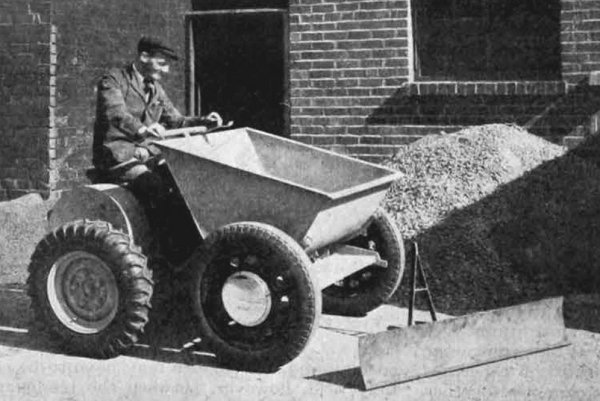|
From 20th May,
1949 edition of The Engineer:
A 10 cwt.
Dumper
We illustrate below a small
dumper developed by George Fowell, Ltd., Smethwick,
and called the "Builders' Mate."
The prototype of this machine was exhibited at the
British Industries Fair. It is designed to carry a
maximum hopper load of 10 cwt, or 8 cwt when
travelling over soft ground, or, alternatively, to
carry ½ cubic yard of earth or muck, or the contents
of the drum of a 10/7 concrete mixer.
The dumper is powered with a 5
hp. Petter engine, one forward gear and one reverse
gear giving maximum speeds of 3½ mph. and 2½ mph.
respectively. The differential gear and final drive
to the road wheels are in the main gearbox and have
been specially designed for heavy duty.
Heavy type Dunlop Girling
brakes are fitted to the 6·00-16 heavy pattern
traction driving wheels, which give good adhesion on
soft ground. The fore-carriage is carried on 29 inch
by 5 inch tyres. The chassis is designed to allow
the hopper section to ride up over very uneven
ground and to turn at a steep angle while the rear
portion remains steadily horizontal. This is
accomplished by connecting the fore-carriage to the
main frame through a special rubber joint. The
hopper tips by gravity and can be replaced by
pulling a chain from the driver's seat.

“Builders’ Mate” Dumper.
The small blade shown in the
foreground of the illustration is a calf-dozer
attachment; this blade can be fitted to the central
channel which forms the main chassis member, and
then used for light back-filling operations.
It is claimed that the controls
have been specially developed for inexperienced
drivers, and can be mastered by anyone in a few
minutes. The machine will circle within a diameter
of 13ft. Its main dimensions are; length 6ft. 6in.;
width 4ft 2in.; height 3ft 9in.; and it weighs
11 cwt. |